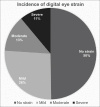Prevalence and risk factor assessment of digital eye strain among children using online e-learning during the COVID-19 pandemic: Digital eye strain among kids (DESK study-1)
- PMID: 33323599
- PMCID: PMC7926141
- DOI: 10.4103/ijo.IJO_2535_20
Prevalence and risk factor assessment of digital eye strain among children using online e-learning during the COVID-19 pandemic: Digital eye strain among kids (DESK study-1)
Abstract
Purpose: The aim of this study was to determine prevalence, symptoms frequency and associated risk factors of digital eye strain (DES) among children attending online classes during COVID-19 pandemic.
Methods: The online electronic survey form was prepared on the Google app. Children/parents were asked to indicate the total duration of digital device use before and during COVID era. The symptoms of DES, its severity and frequency were recorded & measured with the Computer Vision Syndrome Questionnaire.
Results: Two hundred and sixty one parents responded to the questionnaire, of these 217 were complete. Mean age of children was 13 ± 2.45 years. Mean duration of digital device used during COVID era was 3.9 ± 1.9 h which is more than pre COVID era (1.9 ± 1.1 h, P = <0.0001). 36.9% (n = 80) were using digital devices >5 h in COVID era as compared to 1.8% (n = 4) before COVID era. The most common digital device used were smartphones (n = 134, 61.7%). One hundred and eight children (49.8%) were attending online classes for >2 h per day. Prevalence of DES in our cohort is 50.23% (109/217). Of these 26.3% were mild, 12.9% moderate and 11.1% of severe grade. Most common symptoms were itching and headache (n = 117, 53.9%). Multivariate analysis revealed age >14 years (P = 0.04), male gender (P = 0.0004), smartphone use (P = 0.003), use of device >5 h (P = 0.0007) and mobile games >1 h/day (P = 0.0001) as independent risk factors for DES in children.
Conclusion: There is an increased prevalence of DES among children in COVID era. Parents should be considerate about duration, type and distance of digital device use to avoid DES symptoms in children.
Keywords: COVID pandemic; Children; Digital eye strain; computer vision syndrome; online classes and e-learning.
Conflict of interest statement
None
Figures
References
-
- [Last accessed on 2020 Oct 06]. Available from: https://government.economictimes.indiatimes.com/news/education/covid-19-... .
-
- Portello JK, Rosenfield M, Bababekova Y, Estrada JM, Leon A. Computer-related visual symptoms in office workers. Ophthalmic Physiol Opt. 2012;32:375–82. - PubMed
-
- Hagan S, Lory B. Prevalence of dry eye among computer users. Optom Vis Sci. 1998;75:712–3. - PubMed
-
- Reddy SC, Low CK, Lim YP, Low LL, Mardina F, Nursaleha MP. Computer vision syndrome: A study of knowledge and practices in university students. Nepal J Ophthalmol. 2013;5:161–8. - PubMed
MeSH terms
LinkOut - more resources
Full Text Sources
Other Literature Sources
Medical



